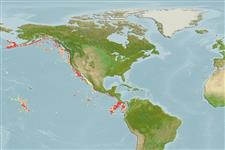Environment: milieu / climate zone / depth range / distribution range
Ökologie
seewasser bathydemersal; tiefenbereich 700 - 1900 m (Ref. 26773). Deep-water
Northeast Pacific: Bering Sea to Baja California, Mexico.
Size / Gewicht / Alter
Maturity: Lm ? range ? - ? cm
Max length : 10.2 cm SL Männchen/unbestimmt; (Ref. 26773)
Kurzbeschreibung
Bestimmungsschlüssel | Morphologie | Morphometrie
Rückenflossenstacheln (insgesamt) : 0; Rückenflossenweichstrahlen (insgesamt) : 69; Afterflossenstacheln: 0; Afterflossenweichstrahlen: 61. Pectoral fin distinctly notched (Ref. 26773). Skin, oral and branchial cavities black; pyloric caeca pale (Ref. 26773).
Inhabits the continental slope (Ref. 26773).
Life cycle and mating behavior
Maturities | Fortpflanzung | Spawnings | Egg(s) | Fecundities | Larven
Stein, D.L., 1978. A review of the deepwater Liparidae (Pisces) from the coast of Oregon and adjacent waters. Proc. Cal. Acad. Sci. 127:1-55. (Ref. 26773)
IUCN Rote Liste Status (Ref. 130435)
Bedrohung für Menschen
Harmless
Nutzung durch Menschen
Tools
Zusatzinformationen
Download XML
Internet Quellen
Estimates based on models
Preferred temperature (Ref.
123201): 2.6 - 4.7, mean 3.9 °C (based on 50 cells).
Phylogenetic diversity index (Ref.
82804): PD
50 = 0.5000 [Uniqueness, from 0.5 = low to 2.0 = high].
Bayesian length-weight: a=0.00525 (0.00237 - 0.01161), b=3.15 (2.96 - 3.34), in cm total length, based on LWR estimates for this (Sub)family-body shape (Ref.
93245).
Trophic level (Ref.
69278): 3.4 ±0.5 se; based on size and trophs of closest relatives
Widerstandsfähigkeit (Ref.
120179): hoch, Verdopplung der Population dauert weniger als 15 Monate. (Preliminary K or Fecundity.).
Fishing Vulnerability (Ref.
59153): Low vulnerability (10 of 100).
